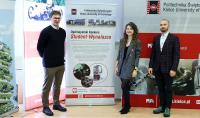An idea from PW can save children’s lives

A team of students and scientists from the Faculty of Power and Aeronautical Engineering is working on the project
A team from the Warsaw University of Technology is working on a device to monitor the vital signs of infants during sleep. The invention is designed to detect signals of cot death and enable a quick response. The project has just been awarded in the thirteenth edition of the nationwide “Student-Inventor” competition.
Sudden infant death syndrome (SIDS) is a serious problem. Its causes are not obvious. It affects babies who seem perfectly healthy, and happens primarily during sleep (but not necessarily in bed and at night). SIDS is associated with a decrease in oxygen in the blood – the child stops breathing. Doctors and scientists are trying to determine the factors that increase the risk of cot death and develop recommendations that will protect against it.
The team from the Faculty of Power and Aeronautical Engineering of the Warsaw University of Technology went a step further – they are working on an invention that will detect SIDS.
The project involves students Julia Wilk, Mikołaj Miszczak, Michał Skibiński and Jan Piliszczuk, and scientists Dr. Edyta Rola and Prof. Cezary Rzymkowski.
A complex solution
– Our device consists of a sensor system with an information processing system aimed at identifying the occurrence of cot death in an infant, explains Mikołaj Miszczak. – The system is based on a neural network with a sequential architecture, which allows you to adjust the criteria for identifying the occurrence of a life-threatening situation individually for a specific infant. This allows for a more accurate detection than in other devices used so far.
The set of sensors consists of a (roll-out) pressure mat placed in the child’s bed, as well as a band/ bracelet adapted to the size of the baby’s hand and put on the wrist – similar to those worn by many adults to track their pulse, for example.
A transmitter and receiver make up the measurement and data analysis kit.
– The transmitter contains the heart of the system – a minicomputer that performs calculations and controls parameter readings, says Julia Wilk. – We are thinking about the design of the receiver, but it will certainly be something no bigger than the size of an air freshener, so that it can be discreetly placed in a house or flat.
In the case of a disturbing reading, we hear a signal through a receiver with a speaker placed in the parents’ or guardians’ room. In addition, they are informed through an app about the probable nature of the threat and instructed on further actions: how to provide direct assistance or how to get to the nearest medical facility.
First prize
The project is in its conceptual phase. However, it has already been recognized in the “Student-Inventor” competition organized by the Kielce University of Technology. Out of 123 submitted works, five were awarded, including the one from the Warsaw University of Technology. Now our team will present their idea at the International Exhibition of Inventions in Geneva (26-30 April 2023).
– We are aware that our project is in line with the current trend of personalised medicine and its development would contribute to increasing parents’ peace of mind and children’s safety, emphasizes Julia Wilk. – We see the cooperation between engineering and medicine as extremely important, and now even necessary. In the future, we want to verify the quality of our idea and move from the conceptual to the test phase.







